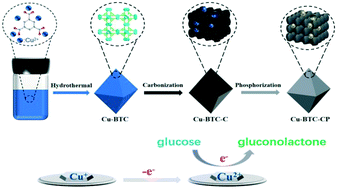MOF-derived carbon-coated cuprous phosphide nanosheets for electrocatalytic glucose oxidation†
Abstract
The exploitation of cheap and stable electrode materials to improve the electrocatalytic detection of blood glucose has recently been attracting much attention. Herein, a type of carbon-coated cuprous phosphide (Cu3P) nanosheet embedded into a metal–organic framework (MOF) derived porous carbon network, denoted as Cu-BTC-CP, can be conveniently prepared by carbonization and phosphorization on the bulk MOF single crystals. These obtained Cu3P particles are structurally endowed with high conductivity, large porosity and abundant active species and exhibit a more excellent glucose oxidation activity in comparison with the carbonized counterpart of Cu-BTC-C. Furthermore, the performed electrochemical results show that the as-made sensor based on Cu-BTC-CP presents a wide linear range of 40 μM–6 mM and a modest anti-interferent property, which makes it a type of competitive electrochemical sensor for practical glucose sensing. The present work provides new ideas and strategies for the rational design and syntheses of MOF-derived highly efficient nanomaterials with satisfactory selectivity as well as reproducibility in the various fields of enzyme-free guest-sensitive applications.



 Please wait while we load your content...
Please wait while we load your content...